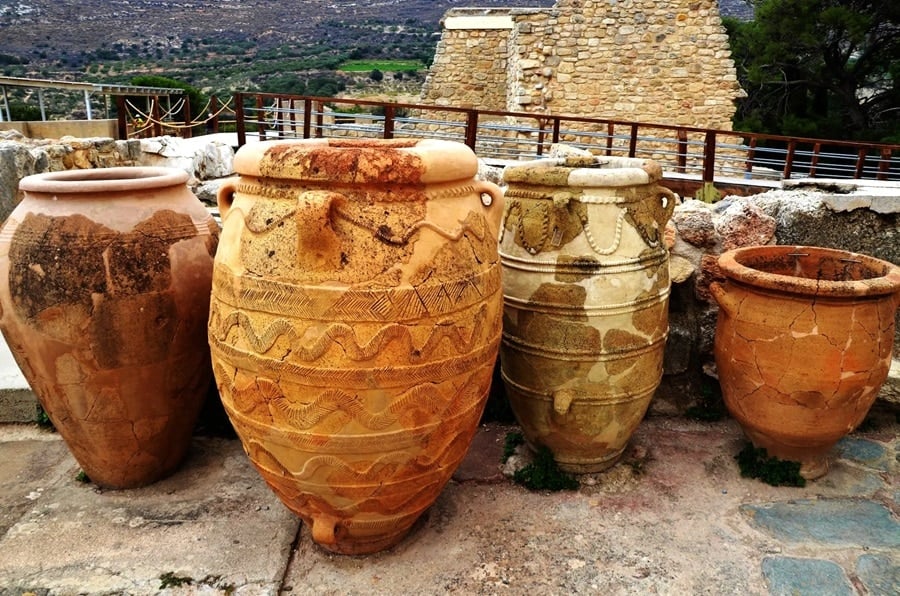

An article published in The Conversation suggests that the ancient Greeks on Crete may have cheated the Romans by exporting “knock-off” versions of their highly prized raisin wine.
For centuries, “raisin wines,” made by drying grapes before fermentation, were a coveted luxury in both ancient Greece and Rome. These sweet, rich concoctions demanded patience and time, with Roman agricultural writers like Columella noting that the combined drying and fermentation process could take at least a month. Pliny the Elder even described a meticulous method involving partial vine-drying followed by eight days on racks before pressing.
However, new archaeological investigations by Dr. Conor Trainor, an Assistant Professor at University College Dublin, suggest that Cretan wine producers in the Roman era might have been cutting corners. His decade-long study at the archaeological site of Knossos – famous for its earlier Minoan remains, but renowned throughout the Roman Empire for its high-end sweet raisin wine – hints at a potential deception.
“What my archaeological investigations of a wine production site, as well as at wine shipping container (amphora) production sites at Knossos, reveal is that Cretan wine-producers may have been deceiving their Roman-era customers with a knock-off version of passum,” states Dr. Trainor in an article published in The Conversation. He adds, “We’re seeing a pattern that suggests a deviation from the traditional, time-consuming methods of raisin wine production.”

Crete, with a winemaking legacy stretching back thousands of years (archaeological evidence from Myrtos suggests practices as early as 2170 BC), became a Roman conquest after a brutal three-year campaign in 67 BC. Following the conquest, Rome established a colony at Knossos, dramatically expanding wine production to capitalize on the island’s strategic location.
The sheer volume of amphorae – clay jars used for transporting wine – found at Roman-era sites in Crete suggests a massive export operation. Romans were eager buyers, partly due to convenient shipping routes; grain shipments from Alexandria to Italy, vital for feeding Rome’s populace, frequently stopped at Crete, allowing merchants to load additional cargo, Trainor notes.
But the primary driver was the esteemed reputation of Cretan raisin wine, a luxury akin to Italy’s appassimento wines today, and even valued for supposed medicinal properties. The Roman army physician Pedanius Dioscorides, in his influential medical work Materia Medica, claimed it cured headaches, expelled worms, and promoted fertility.
This sudden surge in demand for sweet Cretan wine in Rome and the Bay of Naples during the early days of the Empire may have pressured winemakers to accelerate their production methods.
While Pliny the Elder documented one shortcut for raisin wine – boiling grape juice – the mixing basins unearthed at Knossos show no evidence of heating. This points to another intriguing possibility: the addition of honey to wine before shipping.
Dr. Trainor’s team uncovered a repeated pattern of four key artifacts at Roman-era pottery kilns in one region of Knossos: amphorae for wine transport, amphora stands for filling, large ceramic mixing bowls, and, most tellingly, ceramic beehives.
“These beehives, identifiable by their rough interior surfaces designed for honeycomb attachment, strongly suggest a direct connection between winemaking and honey production,” the scientist says. Similar discoveries at other Greek sites further support the idea that honey and wine may have been blended before export.
“The presence of these beehives in close proximity to wine production and shipping areas is too strong a correlation to ignore,” Dr. Trainor explains. “It strongly suggests that honey was being used not just as an additive, but perhaps as a substitute for the lengthy drying process.”
This method would have been significantly quicker and cheaper than the weeks-long process of meticulously drying grapes. But if Cretan producers were indeed substituting honey for traditional drying techniques, was it truly raisin wine? And, crucially, were Roman consumers aware of this potentially “knock-off” version of their beloved passum?
Based on the vast quantities of now-empty Cretan wine amphorae discovered in archaeological sites across Rome, Dr. Trainor suspects that authenticity might not have been the Romans’ top concern.
The sheer volume implies that the Roman populace likely cared less about the precise production method and more about the availability and perceived quality of their desired sweet wine, perhaps making them unwitting beneficiaries—or victims—of ancient Cretan ingenuity.
Related: Rome Conquered Greece, and Then Greece Conquered Rome
